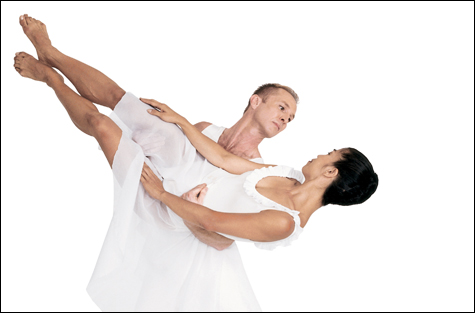
AUREOLE: Lisa Viola and Patrick Corbin in 2007 — the choreography has changed hardly at all.
|
Dancers are working with character more frequently, after decades of choreography drenched in physical accomplishment. It’s another phase in a perennial campaign aimed at relating the dance to the audience. As if dancing by itself weren’t human enough. At Concord Academy Summer Stages last week, Headlong Dance Theater of Philadelphia took off from an Isaac Bashevis Singer novel, Shosha, about love and unworldly delusion in Poland during the rise of the Nazis.
The 50-minute dance retains the merest thread of a story about a naive young couple (Nichole Canuso and David Brick) who discover love, marry, and are parted by death. Two other women (Amy Smith and Niki Cousineau) tempt the boy with sensuous tangos, but after taking notes on their arch seductiveness, he returns to Shosha, trying by degrees to overcome her fear of intimacy.
Their relationship is framed — managed — by a vintage 1970s theater director (Andrew Simonet), who smirkingly explains the whole play to the audience with too-big gestures and fake geniality. He then turns to his willing actors. On this level of the performance, the characters are supposed to emerge from the kind of theater games and pseudo-psychological studio stuff that experimenters practiced in the heady days of the counterculture. Canuso and Brick are wrapped in some imposed tangle of limbs; Simonet stands back and scrutinizes them. After perfunctory reassurances (“Terrific, terrific”), he eggs them on (“Let’s think of it as very intimate, and personal? But project.”). The dancers look at each other intently, push themselves into a more crabbed and off-balance position.
The piece goes back and forth between Singer’s fictional characters and Headlong’s simulated improvisers, sometimes cutting abruptly to Simonet’s directorial interventions. After several tender duets, Canuso is dressed for her wedding, and Brick, perhaps at the end of his patience, throws himself on her in a brutal deflowering. “Okay, okay, stay,” says Simonet, launching into further encounter-speak.
As the two stand side by side, perhaps about to be married, Canuso turns to look at Brick, and, with a clap of thunder, he slips away. She slowly steps into a big trunk where he’d stored his books. She curls up and closes the lid. He comes and locks the trunk and drags it off. The little town of cardboard houses that she was building at the beginning of the piece blows away in a manufactured wind.
Five real men told their stories to Gideon Obarzanek, choreographer/director of the Australian company Chunky Move, which returned to Jacob’s Pillow two weeks ago. For a documentary, they talked about how they felt about dancing, and their revelations spun off into a staged version, supplying a verbal and video text for I Want To Dance Better at Parties. Five large screens hung at the back of the space in the Doris Duke Studio Theatre, each with a figure outlined on it. As each man told his story to the camera, a live dancer became his alter ego.
The subjects revealed a surprising amount about themselves in words. Two of the men had learned to love the folk dances of their immigrant parents. One guy liked going out with his gay clog-dance group. A widower discovered dance lessons as a way out of his loneliness. One man stubbornly couldn’t see himself dancing, ever.
Extrapolating from these personal stories to bigger social situations, the dancers swung into Greek line dances, Israeli folk stuff, and party scenes. In a mass concluding melee, they slammed into one another, threw one another to the floor on the run — acting out the machismo aggression that civilized recreational dancing often keeps at bay.
The cast included two women, but I don’t know whether that was simply the result of who happened to be available to the choreographer or whether some more profound observation was to be made. For me, it was the words of the original subjects that were revealing and moving. Except for the hair-raising riot scene, Chunky Move’s dancing seemed mostly metaphorical.
Jacob’s Pillow these days is either a critic’s bonanza or a critic’s nightmare, depending on how much time you have. Two Saturdays ago, before Chunky Move, I saw the first of two different Paul Taylor programs and a discussion among Obarzanek, Michelle Potter, the native Australian who now heads the Dance Library at Lincoln Center, and Pillow scholar-in-residence Maura Keefe. Plus an informal Inside/Out presentation of Taylor and Alonso King work by 21 students in the Contemporary Dance Traditions program led by Milton Myers.
It could have been exhaustion or overload, but the next day I found myself watching Taylor’s Aureole with double vision. It was an anniversary of sorts. I attended its very first performance at the American Dance Festival, almost 45 years ago to the week. Taylor’s company now is full of wonderful, distinctive dancers, but their interpretation of Aureole looks pushier, softer, more technical but easier, and at times almost slap-happy. The choreography has changed hardly at all. It speaks for a dance’s genius when it can submit to such evolution and still be imprinted in the mind with its original performers. We have no one on our stages today like Paul Taylor, or Dan Wagoner, Elizabeth Walton, Sharon Kinney, and Renee Kimball. We must remember that.